Towering above the city of Strasbourg, Notre Dame cathedral is an icon of gothic architecture and a collaboration of French and German culture. Built over several centuries and combining both the Romanesque and Gothic styles, its pink sandstone walls and circular Rose window have influenced architecture across the continent of Europe.
Iconic Architecture at Strasbourg Cathedral
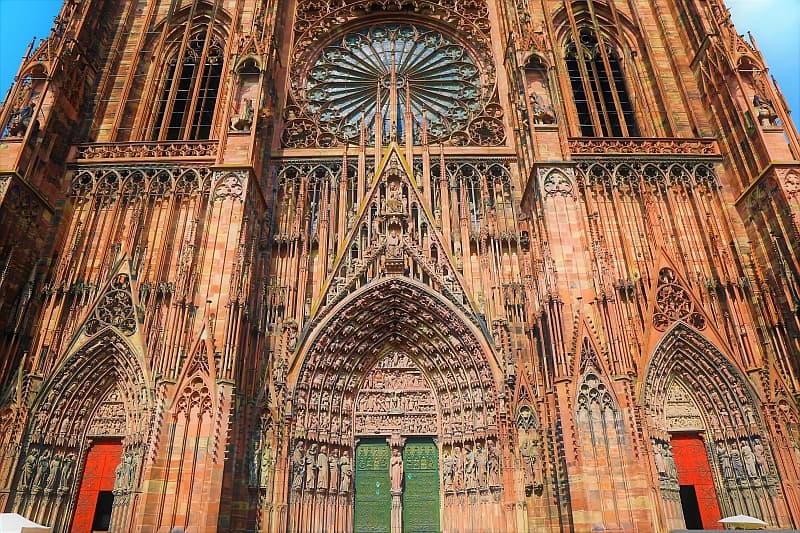
About Strasbourg Cathedral
Construction on Strasbourg’s Notre Dame cathedral dates to 1015, though the crypt and footprint are now the only remaining part of the building from this time in its history. Work on the current cathedral began in the late 1100s and took over three centuries to complete! Lack of funding was the reason for things taking so long and in 1253, the bishop had to pare back on personal extravagances to finance the completion of the nave.
Erwin von Steinbach redesigned Strasbourg cathedral in the 1260s and his proposals detailed extravagant architectural features and unique decorations. The cathedral in Strasbourg was then under German rule and was designed to be the most modern building in the Holy Roman Empire. The Cathedral of Notre Dame in Strasbourg was daring in its application of gothic style, and unlike other cathedrals in Germany, did not adopt the traditional architectural features of the region.
The next two centuries saw construction slowly completed with a few amendments to the original plans. In 1439, the bell tower was the last part of Strasbourg cathedral to be finished and its spire was finally erected. Reaching 142m tall, Strasbourg cathedral is still the highest medieval structure in Europe. Visitors can enjoy views from a 66m high platform in the tower but, should be prepared to climb 332 individual steps to reach it!

Main Features of Strasbourg’s Gothic Cathedral
Strasbourg cathedral is an excellent example of gothic art, though the building also has Romanesque features dating back to before 1225 when there was a change of craftsmen. With its spire soaring 142m above the city, Our Lady of Strasbourg Cathedral was the highest building in the West until the nineteenth century.
The cathedral is laid out in the traditional cross-shape of Christian churches, with a long nave at its entrance. Built in the Romanesque style, the chancel at the front of the cathedral is the oldest visible part and it conceals an 11th century crypt below. Many of Strasbourg Cathedral’s stunning stained-glass windows depict biblical scenes and date from the 12th and 14th centuries.
The Passion of Christ was the inspiration for the central portal’s decorations on the façade and this section is richly adorned with statues of prophets from the Old Testament. Also at the front of the cathedral is the Rose Window, which measures 15 metres in diameter. Featuring ears of wheat, it is completely unique to Strasbourg cathedral and represents the city’s commercial power in the Middle Ages.
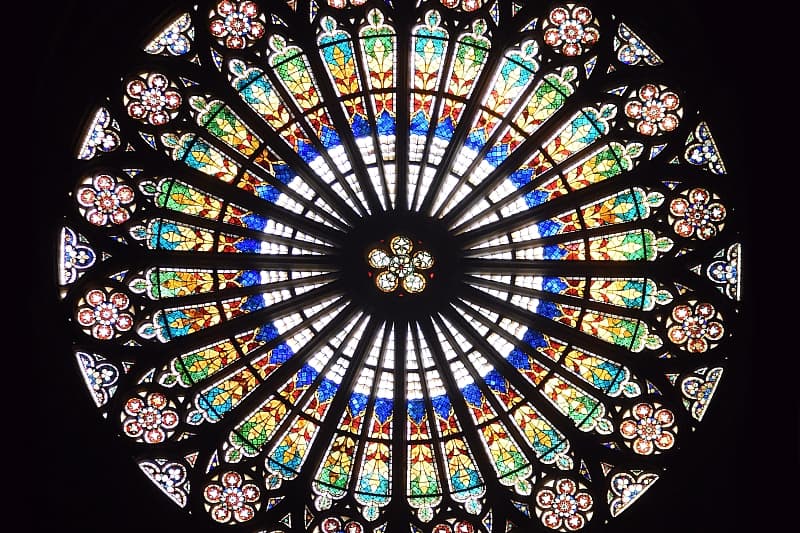
Strasbourg Minster’s hundreds of sculptures line the outside of the cathedral and were designed to silhouette the sky, making use of light and shadow throughout the day. The colour of the sandstone also changes relative to the light illuminating it. The walls glow pink or brown according to the time of day, though unfortunately, pollution has given the sandstone of Strasbourg cathedral a grey tinge.
Other features to look out for on your visit are the organ, which is equipped with small, animated figures and the Renaissance clock. Built by mathematicians, artists and experts, the Renaissance Clock is a marvel of technology that still has a working mechanism inside dating to 1842!

Strasbourg Cathedral – A Protestant Place of Worship
Built as a Catholic place of worship, Strasbourg cathedral changed alliance during the reformation. In the 1500s, Martin Luther’s writings spread throughout Germany, with Strasbourg and the Cathedral of Notre Dame becoming a protestant stronghold. In 1518, Luther’s theses were nailed to the doors of the cathedral and reformist ideas surged around the town, aided by the high proportion of print houses.
By 1524, Strasbourg had been declared a ‘Free City’ of the Holy Roman Empire. The Habsburg ruler, Charles V, was less than impressed, and sought to return the city to Catholicism. Strasbourg and its cathedral remained protestant for over a century, only eventually being reinstated as ‘Catholic’ in 1681 by the French King, Louis XIV, following the Wars of Religion.
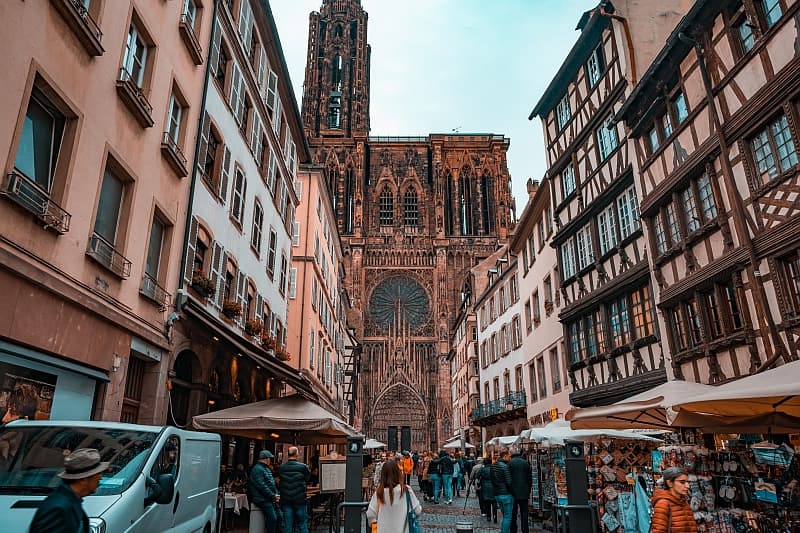
Gothic Revival in the 1800s
Strasbourg’s cathedral had fallen out of style by the late eighteenth century, but interest in it was revived after a German poet and playwright visited the city. Johann Wolfgang von Goethe was so taken by the cathedral that he was inspired to write an essay titled ‘On German Architecture’. Describing Strasbourg’s Cathedral of Notre Dame as a “sublimely towering, wide-spreading tree of God”, he was fascinated by the conflicting identity of the cathedral, which has been uniquely defined by a collision of cultural influences from both France and Germany.
Goethe’s work led to a Gothic resurgence in nineteenth century France. Politician, Victor Hugo, romantically wrote that Strasbourg cathedral was “a skilful combination of monumental size and delicateness”. Incredibly, the sudden reinterest in Strasbourg’s Gothic architecture influenced the redesign of the Notre-Dame cathedral in Paris!

Conflict at Strasbourg Cathedral
During the French Revolution, a decision was made to smash the Gallery of Apostles at the top of the south façade. At this time, over 230 statues were destroyed. However, amazingly, a local official was able to save 67 other statues from the same doom by hiding them from republicans.
When the Franco-Prussian wars struck in 1870, Strasbourg cathedral came under siege again. Its nave and choir stalls were hopelessly set alight and destroyed during the conflict. As if this wasn’t enough, disaster struck a third time during the First World War when all its bells were removed. World War Two saw Strasbourg cathedral’s medieval stained-glass windows taken away by German forces. Thankfully, these priceless artefacts were recovered in 1945 by Allied forces in a German salt mine, and swiftly returned to the Notre Dame Cathedral in Strasbourg.
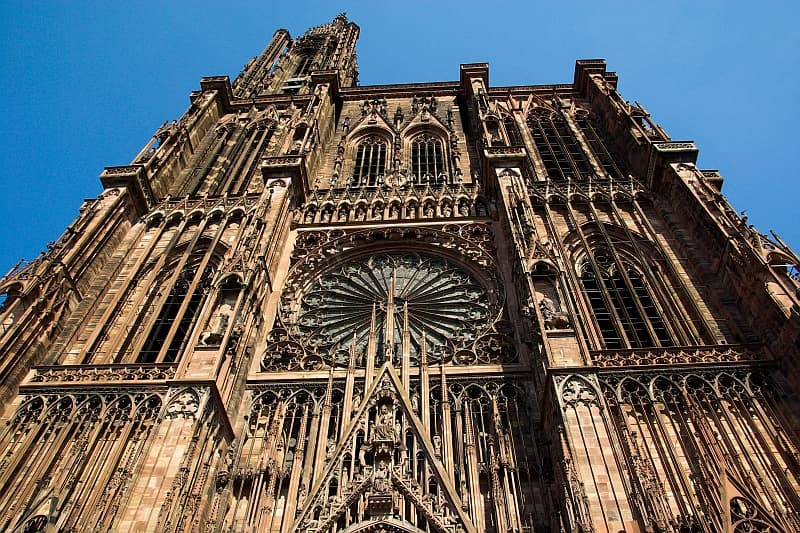
UNESCO World Heritage Listed Landmark
Strasbourg cathedral was listed on the UNESCO World Heritage List in 1988. Its designation is linked to the historic centre of Strasbourg, which was built around the cathedral in splendid Gothic style during the German Administration of 1871-1918. The resulting urban space surrounding the cathedral is individual to Strasbourg and sees its buildings falling away to views of landscapes, rivers and canals.
Visit Strasbourg Cathedral on a Luxury Barge Cruise
Panache will take you through the meandering canals of the Alsace region, culminating in a tour of the area. The highlight is a trip to the stunning city of Strasbourg, where guests will visit the awe-inspiring facades of the famous Strasbourg Cathedral.
For more information on our cruises in Alsace, and the rest of our collection of luxury hotel barge cruises, why not order a free copy of our brochure or speak to a member of our team directly using our handy Contact Form.
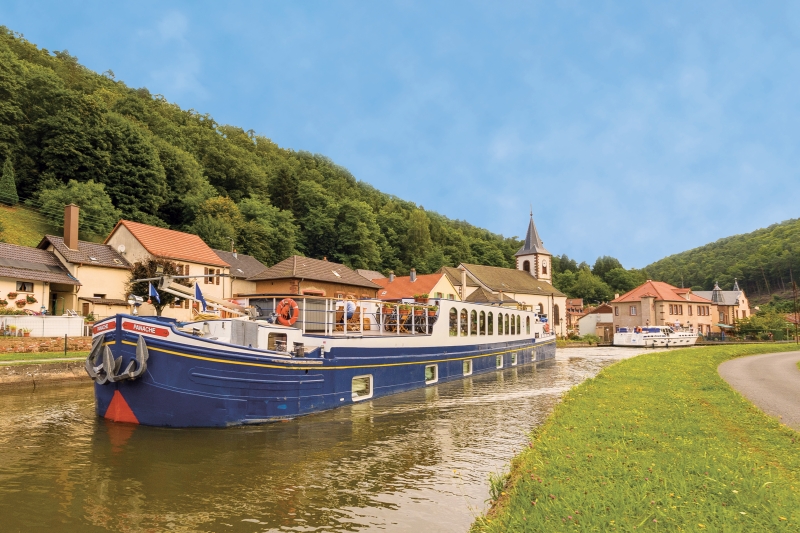
 English
English
 Spanish
Spanish French
French German
German Norwegian
Norwegian Portuguese
Portuguese Swedish
Swedish Italian
Italian Russian
Russian Simplified Chinese
Simplified Chinese Japanese
Japanese